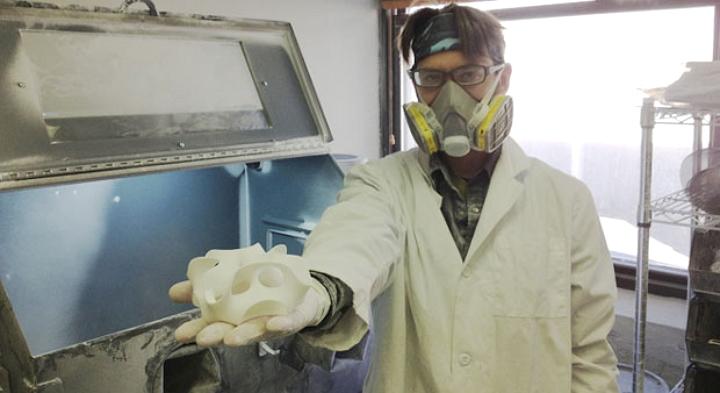 Rachel Spieczny is a PMP Certified Project Manager who works in the architecture and high-tech fields, and she also helped Zeepro, the 3D printer manufacturer, raise $348,000 on Kickstarter for their startup.
Rachel Spieczny is a PMP Certified Project Manager who works in the architecture and high-tech fields, and she also helped Zeepro, the 3D printer manufacturer, raise $348,000 on Kickstarter for their startup.
Spieczny says that, while she’s a 3D printing booster of long standing, one element of the technology has gone begging when it comes to study and investigation – the safety of the process to users.
“We need to be asking the tough questions, and doing everything we can to ensure 3D printing is safe for everyone,” Spieczny says. “My hope is that this project will raise awareness, encourage further research, and promote dialogue about 3D printing and consumer safety.”
 According to Spieczny, there’s been precious little research been done on the air quality in businesses, homes and schools where 3D printers are in operation. She cites industrial certifications exist like ROHS and REACH as examples of those standards, but notes that there are no certifications meant to specifically address consumer use of plastic 3D printing filaments.
According to Spieczny, there’s been precious little research been done on the air quality in businesses, homes and schools where 3D printers are in operation. She cites industrial certifications exist like ROHS and REACH as examples of those standards, but notes that there are no certifications meant to specifically address consumer use of plastic 3D printing filaments.
That’s why she’s using Kickstarter to fund the Clean Strands initiative.
The idea is a bit tougher than it might sound, as filament manufacturers use proprietary formulations, and since PLA and ABS are heated up to 428°F – or 220°C – in many cases they emit fumes which may or may not contain harmful elements.
Spieczny says the Clean Strands initiative would work to discover which chemicals are being emitted into the environment when PLA and ABS are heated, and in what concentrations.
She says Clean Strands will work to test the emissions of those 3D printing filaments with the Built Environment Research Group (BERG) at the Illinois Institute of Technology. According to Spieczny, BERG remains the only research lab to publish an extensive study on indoor air quality and 3D printing.
If the initiative is funded, Clean Strands will have BERG’s founder, Dr. Brent Stephens, test for the presence of UFPs (ultra-fine particles) and TVOCs (total volatile organic compounds) emitted for some 10-20 PLA and ABS filaments under varying printing conditions.
 Clean Strands then says they’ll use that data to set a standard for safe indoor air quality, and working in partnership with Ramboll ENVIRON, an environmental consultancy specializing in air emissions, a team there, led by Joseph W. Hower, will then evaluate which chemicals could be hazardous to health and to the environment.
Clean Strands then says they’ll use that data to set a standard for safe indoor air quality, and working in partnership with Ramboll ENVIRON, an environmental consultancy specializing in air emissions, a team there, led by Joseph W. Hower, will then evaluate which chemicals could be hazardous to health and to the environment.
Backers, as well as filament manufacturers, members of the 3D printing industry and the general public will then have access to the final report upon publication. Spieczny says that once the findings have been made public, Clean Strands will then seek out filament manufacturers to encourage them to display a Clean Strands Seal of Approval on their materials which qualify.
“The availability of affordable and child friendly 3D printers has opened up a whole new world of innovative design and creative expression that links the digital and physical worlds,” Spieczny says. “This is a powerful educational tool for educators, as well as a way for students to engage in authentic solutions to real world issues and applications. The availability of a filament that is free of toxic fumes makes administrators, like myself, literally breathe easier in making 3-D printers readily available to our students.”
You can check out the various levels of backing commitment for the Clean Strands Kickstarter campaign here…
Do you think the 3D printing community needs an initiative like Clean Strands? Let us know in the Clean Strands forum thread on 3DPB.com.
Subscribe to Our Email Newsletter
Stay up-to-date on all the latest news from the 3D printing industry and receive information and offers from third party vendors.
You May Also Like
NSF Awards Kentucky $1M for Advanced Manufacturing
The National Science Foundation has awarded a $1 million grant to the University of Louisville for the Advancing Manufacturing and Building Construction Technologies (NSF AMT) project. This initiative is part...
3D Printing News Briefs, May 11, 2024: 3D Printed Stent, Tower, Sculptures, & More
We’re starting off with medical research in today’s 3D Printing News Briefs, as researchers in Korea used CT images and 3D printing to fabricate an educational simulator for a mastoidectomy....
3D Printing Unpeeled: Wind Turbines, Probiotics and Lenses
TPI Composites, ORNL and Ingersoll Rand are working to make wind turbine tooling segments that can be 18.3 meters long. These elements also include resistive wires that help keep the...
Tethon 3D Releases Cost-effective Bioprinter
Tethon 3D, known for its ceramic-loaded DLP materials, custom resins, and DLP 3D printers, has recently released a bioprinter. Vat polymerization printers like DLP systems have been widely used by...
































